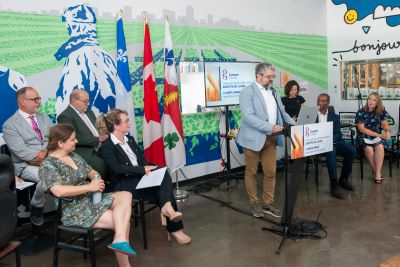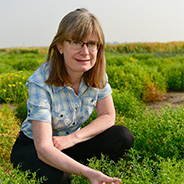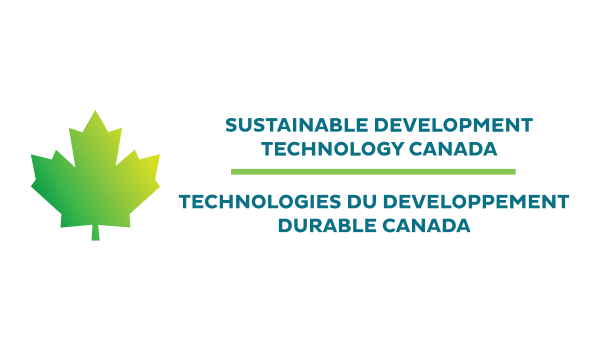Genome Canada pioneers novel “portfolio” investment approach in climate-smart projects
One important goal of research and innovation is to achieve the maximum benefits from the R&D investment.


Nine new projects in the Genome Canada-led Climate-Smart Agriculture and Food Systems initiative – to reduce the carbon footprint of Canada’s food production system – are designed to do just that, says Ryan Philippe, director, strategic partnerships and innovation, at Genome Canada. (Photo at right: Ryan Phillipe. Photo at left: Rob Annan, president of Genome Canada, announcing new projects).
“The challenge of climate change and food systems involves system-level problems. System-level challenges require systems-level approaches if we’re going to change those systems,” he told Research Money.
Genome Canada is using a novel “portfolio” investment approach for the nine projects. The aim is to ensure the projects yield economic, environmental and social benefits. Additional benefits expected include interdisciplinary and inter-sector collaboration, shared data on research, and national knowledge transfer.
Genome Canada’s $30 million investment in the nine new projects, including funding for new data and knowledge mobilization hubs, has leveraged an additional $42 million for the projects from co-funding partners. That’s well above the one-to-one matching investment Genome Canada requires.
“There’s a lot of interest, a lot of opportunities that these organizations realize are there,” Philippe said.
He rejected the often-heard opinion that investment money is hard to come by in Canada. “We just have to be able to speak the same language and align the value systems properly, so that desire, that buy-in into the investment, can be realized.”
“Aligning those values happens when you integrate within the projects and across the portfolio,” Philippe added.
Portfolio systems approach interlinks projects
Genome Canada’s portfolio systems approach builds on the independent, federally funded not-for-profit organization’s “GE3LS” approach in funding genomics research and innovation. GE3LS requires researchers supported by Genome Canada to consider the environmental, ethical, economic, legal and social implications of their projects.
“It’s basically getting researchers to do the work to understand what are the impacts across all of these different areas that are important to human society of the work they’re doing,” Philippe said.
In addition to GE3LS requirements, Genome Canada’s portfolio investment approach required the nine projects funded under the Climate-Smart Agriculture and Food Systems initiative to be integrated among the projects, bring in multiple stakeholders, and encourage follow-on private sector investment.
For example, a project on soil health is linked with a project on how cows grazing on different kinds of soil affect cow development and emissions. Those projects are in turn linked to a project on dairy cattle and their emissions – and so on throughout the project portfolio.
“By tying the projects together in this portfolio and getting them to work together from the beginning, and supporting them with a group of researchers and essentially university leaders in data and knowledge mobilizations, we’re there to catalyze that interaction that’s going to extract more value that only exists at the interface of these programs,” Philippe explained.
To ensure data is shared among researchers and with the broader community, and to widely disseminate the knowledge gleaned from the projects, Genome Canada’s initiative also includes a new Data Hub and a new Knowledge Mobilization Hub.
The Data Hub, with funding of about $4 million from the $30-million Genome Canada contribution, will enable research teams from all nine projects to share valuable data assets with each other and with academic, government and industry initiatives. It will be Canada’s first national agricultural and agri-food genomics data hub for climate action.
The Knowledge Mobilization Hub, with funding of about $2 million, will help get the projects’ outcomes, including new products/processes, into the hands of those who will actually use them. The hub will share the knowledge generated across the research teams and with communities, producers, companies, consumers, government agencies and other users.
“These hubs will essentially enable that interface to happen,” Philippe said. “They allow these groups to speak the same language and to share the same values that will catalyze [follow-on investment].”
Accessible data and knowledge dissemination are crucial
Access to the projects’ data in the public domain is “supercritical, because if you don’t let follow-on investors like industry access your data to be able to create innovations, then you’re missing a massive opportunity,” Philippe said.
The Knowledge Mobilization Hub will “take benefits that accrue in a region or in a sector and enable them to spread nationally," he added.
As an example, Philippe said, say there are three improved crop programs developed and all may need the same government regulation changed to fully realize the impact of those programs. Instead of having three different groups of scientists try to talk to government regulators, the Knowledge Mobilization Hub will coordinate this activity.
This enables Genome Canada to work with federal regulators to open the door proactively to regulatory improvements, he said. “So we’re shortening the timeline to impact and benefit, and we’re increasing its spread across Canada.”
Genome Canada also implemented other innovative elements in evaluating 38 proposed projects, eventually selecting nine.
The projects had to address regional priorities that could be linked to a broader national impact. Each of the project teams had to show they were willing and able to work together. Diversity of the teams was important, including the various career stages of the researchers.
Philippe said the process for selecting projects also involved a novel group of evaluators, including not only academics but also food economists and farmers.
He said the academics at one point were debating a proposed project and how best to do it. “And the farmer puts up her hand and says: ‘I don’t know about the science, but we’re never going to use this.’” That project was shelved and the farmer’s perspective changed the tone of the conversation.
Canada is well-positioned to be a global leader in genomics technologies
Funding for the nine genomics projects and two hubs comes from a $400-million investment in federal Budget 2021 for a new Pan-Canadian Genomics Strategy, including $136.7 million for Genome Canada to kickstart the strategy.
Philippe expects Canada will see multiple benefits from the projects, including reduced greenhouse gas emissions, improved carbon sequestration in soils, less use of crop inputs such as fertilizers, and new food systems based on a circular-loop economy.
All living organisms have a genome, the code of life by which an organism develops into what it is and then continues to interact with its environment. “So anything that has a genome has the potential to be touched on by genomics research, either in understanding it or innovating around it, or for it, or improving it,” he said.
Canada is well-positioned to be a global leader in genomics technologies, with abundant living natural resources on the land, in the land and in the oceans, Philippe said.
The sequencing of the genome for wheat was led by Canadian researchers, he noted. “We’re leading the way in the development of the lentil market and other pulses which are huge for an alternative source of protein, more sustainable sources of protein.”
However, realizing the global opportunity will require governments to take the risk and invest strategically, Philippe said.
Canada now invests a lot of money in the “push end” of the innovation ecosystem, he said. “But the pull takes all of that money and turns it into value.”
“So we absolutely need this kind of evolution of moving beyond interdisciplinary [research] into that portfolio systems approach, if we’re going to tackle these systems-level challenges.”
Reducing fertilizer emissions
In 2022, the federal government identified a target to reduce fertilizer-related emissions by 30 per cent by 2030, as part of its net-zero strategy.

One of the nine Genome Canada projects focuses on reducing synthetic fertilizer use and the resulting nitrogen dioxide GHG emissions. Kirstin Bett (photo at left) and Curtis Pozniak (photo at right) both professors in the University of Saskatchewan’s College of Agriculture and Bioresources and the Crop Development Centre, are co-leading the project.
The research team aims to use genome sequencing to engineer into wheat species grown in western Canada a portion of genome, or DNA, from a wild grass species that inhibits nitrification – the natural breakdown of nitrogen. The end-goal is to identify which specific gene in the genome is responsible.
By reducing nitrogen losses in soil when nitrogen fertilizer is used, “less nitrogen will escape into the environment either up through emissions or down through leaching,” Bett said in an interview.
More of the nitrogen fertilizer would be available to the crop, so less fertilizer needs to be used, she said. Not only would GHG emissions be reduced in the farmer’s field, but also by using less natural gas to make the fertilizer.
Another part of the project will use genomics in multi-species plant breeding, to try to predict which lines of lentil plants will optimize wheat growth when the two crops are grown in rotation. Crop rotation helps break cycles of diseases and pests, so farmers don’t have to apply as much fungicide and pesticide, and burn diesel fuel doing so which produces emissions, Bett said.
The research team will use genomics techniques, over two successive years rotating between a lentil crop and a wheat crop, to determine what regions of the genome in lentil plants are associated with having a good wheat crop. Lentil breeders can then use this genomic data to select plant varieties that have those wheat-improving genetic characteristics.
The team includes agricultural economists who’ll determine whether it’s cheaper for farmers overall to do lentil-wheat crop rotations, Bett said. “Because if lentil is making your wheat look good, it gives farmers added incentive to actually grow those crops in rotation. It will reduce their costs and increase their bottom line.”
In keeping with Genome Canada’s portfolio investment approach to ensure maximum benefits, the research team works directly with lentil- and wheat-breeding programs and partner grower associations. This makes for much quicker knowledge dissemination and adoption of the project’s output – climate-smart varieties of wheat and lentils.
The team estimates climate-smart cultivars and microbiomes from their project could conservatively lead to more than $1.2 billion in fertilizer cost savings over the next 20 years, at the same time reducing between 2 million to 3 million tonnes of fertilizer-related emissions.
The productivity benefits from improved crop rotations and improvement in crop plant varieties could yield another $1 billion in benefits for farmers over the same period.
Upcycling organic waste to reduce emissions
About 15 per cent of Canada’s national GHG emissions are related to food production, including transportation, processing and storage of food. In Quebec, the 41 per cent of food that’s lost or wasted is also responsible for GHG emissions.
Another project, funded through Genome Quebec, will leverage genomics to reduce GHG emissions by transforming urban agri-food wastes into food or fertilizers. The research team will work with more than 30 microbreweries, bakeries and other producers of organic matter in Montreal, with the city serving as a “living laboratory.”
 The project is co-led by Joan Laur, a member of Université de Montréal’s Plant Biology Research Institute and a botanist at Montreal Botanical Garden, and Louise Hénault-Ethier, associate professor at INRS (National Institute of Scientific Research) and director of its Water Land Environment Center. (Photo at left: Hénault-Ethier at podium, Laur to her right, at project announcement).
The project is co-led by Joan Laur, a member of Université de Montréal’s Plant Biology Research Institute and a botanist at Montreal Botanical Garden, and Louise Hénault-Ethier, associate professor at INRS (National Institute of Scientific Research) and director of its Water Land Environment Center. (Photo at left: Hénault-Ethier at podium, Laur to her right, at project announcement).
The project team includes researchers from the University of Western Ontario and McGill University.
The researchers will use various genomics approaches coupled with microbiology, organic chemistry and plant biology, along with methods from geography, business and social sciences. A big part of the project includes analyzing how bacteria, microorganisms, fungi and insects biodegrade and transform organic waste.
The goal is to optimize the recycling of organic waste using nature-inspired bioreactors like composting, mushroom and insect farming in urban agriculture settings, Hénault-Ethier said in an email to Research Money.
The team will quantify the carbon footprint of different ways to upcycle organic waste, validate business and consumer acceptability of the novel production methods and food or fertilizing products, and examine the impact of expanding such circular clusters across Canada.
Modelling by Hénault-Ethier and project partners shows that in Quebec, more than 160,000 tonnes of carbon dioxide emissions could be avoided if agri-food waste were transformed using decentralized composting, mushroom cultivation and insect farming. In addition, about 200,000 tonnes of additional CO2 could be sequestered in fertilized agricultural soils.
The type of composting reactor the team will study is produced in Quebec and exported across Canada and the world. Better understanding the reactor’s operational parameters to reduce GHG emissions and control pathogens will help expand the market for the reactor system.
Quebec also has many small-scale insect farmers, noted Hénault-Ethier, who co-founded Try-Cycle, a Montreal insect farm. Deploying insect agriculture throughout Quebec, at a human scale rather than using centralized large insect plants, could provide quality jobs for farmers and facilitate local organic waste upcycling – minimizing transportation and GHG emissions, she said.
She added that improving mushroom-farming production methods, by minimizing wasted batches due to contamination, and avoiding energy-intensive sterilization processes, could boost the return on investment for mushroom farmers. These technologies also could be exported.
Said Hénault-Ethier: “We can really reduce the carbon footprint of the agri-food system by creating a circular economy inspired by the natural functioning of ecosystems, and optimize these applications using the power of genomics.”
R$
Events For Leaders in
Science, Tech, Innovation, and Policy
Discuss and learn from those in the know at our virtual and in-person events.
See Upcoming Events
You have 0 free articles remaining.
Don't miss out - start your free trial today.
Start your FREE trial Already a member? Log in
By using this website, you agree to our use of cookies. We use cookies to provide you with a great experience and to help our website run effectively in accordance with our Privacy Policy and Terms of Service.





